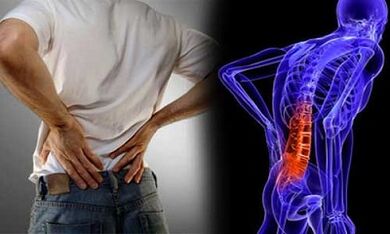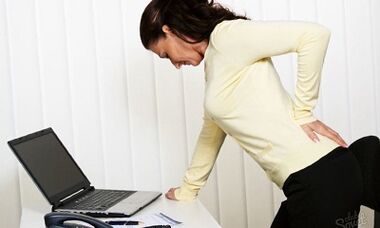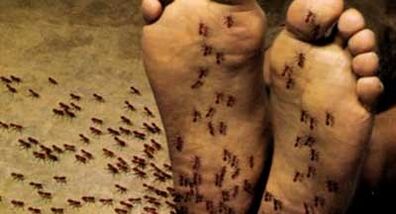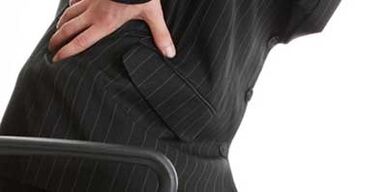Probably you can't find a single adult who didn't know what "lumbar osteochondrosis" is.On average, every third healthy person in the middle and sometimes often had an episode of acute pain in the lower back in his life, and every fifth - sixth points out that such problems occur regularly and are even a "source" of the hospital sheet.
However, in order to explain in detail what exactly has occurred for the violation in the lower back, the patients are most often unable.Most of them have never been examined, and the treatment, which consists in the form of "injections", "ointments", usually helps massage sessions for a period of several months to one year.
If you "pose" such a patient and inquire about the diagnosis, he will explain after suffering a little, that he is sick of "osteochondrosis".What does this disease mean with regard to the lumbar spine?
Osteochondrosis of the lumbar region - a disease or "norm of life"?

First of all, you have to say significantly: "Osteochondrosis" cannot hurt.And in any way it cannot manifest itself, since this is the process of dystrophy and degeneration of the intervertebral discs, ie cartilage, which consists of a pulp core and a fiber ring.The intervertebral disc is cartilage and is designed in such a way that it acts as a shock -absorbing "airbag", the vertical and angular accelerations of soft soft inhibition between neighboring vertebrae.
As you know, the cartilage is free of nervous and vascular tissue, so that the processes that run "purely in the windows" simply do not influence the neighboring structures and do not appear in any way.A similar example in vertebroneurology is the hernia of the shomorle, in which the hernial advantage is reliably covered by the spongy bone fabric of the neighboring vertebra.Intermediate whirlpool does not damage.
Chondrosis (suffix "-o" describes an increase, increase) correctly in this case.It does not occur during the human life of growth and the increase in cartilage.Here with fibrosis (cirrhosis) The liver can be noted that the network structure of the liver developed into the disadvantage of the function.
And with chondrosis (or osteochondrosis), the intervertebral discs only start their configuration under the influence of several years.
They cause pressure on neighboring vertebrae, since according to Newton's law, each action causes exactly the same opposition or reaction of the support in the event of a static load.How does osteochondrosis develop and for what reasons does this happen?
The causes of the "lumbar osteochondrosis"
Signs of an osteochondrosis of the lumbar region (more precisely between the intervertebral windows) can be found at a young age, especially for various violations of the musculoskeletal system.
For example, they can be assigned:
- Congenital anomalies (different legs);
- Different types of flat feet (longitudinal section, cross -quar);
- Deformation of the spine (scoliosis);
- Spondylolistz (slide the lower, lumbar vertebrae from the sacred bone both forward and back).
All of these diseases can cause or increase the base pollution on the spine (for example with flat feet if the elasticity of the foot arch decreases) and with severe asymmetry of the spine if the support function is systematically implemented due to the load on the edge of the hard drive.
It was known that the experiments found that healthy and young cartilage could withstand up to 2000 kg evenly and statically on the entire surface, and even higher for themselves. Of course there is no load in everyday life, but it can increase to such values if they are exposed to the edge of the hard drive.
If the area of the support is 20 times smaller and the hard drive is not so healthy (e.g. in old age), the exposure can cause a disorder from 60 to 80 kg (for example in the inclination on the inclination with a load on the shoulders), which can be in the form of an advantage or succumbing.
It is the appearance of a lead or hernia, which indicates that the disc was deformed and even "crawled" by one or more sides.And as you know, there is no empty place.As soon as the hard drive begins to contact nerve roots, neighboring ligaments and muscles, the consequences of osteochondrosis occur: reflex pain and muscle tonic syndromes that make the patient turn to a neurologist, manual therapist and masseur.
In the meantime, the panes have a normal shape and wear, without extreme loads, then the osteochondrosis of the lumbar spine interferes with the patient no more than the usual age abrasion of the teeth with which the criminals are known.How manifest are reflex pain syndromes?
Symptoms and signs of complicated lumbar osteochondrosis

They have already noticed that we are busy "breeding" bridges: the ordinary osteochondrosis is a completely inevitable process of normal aging elastic gang in "reasonable people" because it moves vertically in the course of life.And the "osteochondrosis", which are reminiscent of patients with acute pain, is a complicated illness.
We may start with signs of radicular compression.Signs of lumbar osteochondrosis are of course connected to pain due to the segmental vertebrae spine pressed by the hard drive.In addition to pain, sensitive, motor and vegetative trophic disorders are possible.
Lows pain in osteochondrosis have the following properties:
1) Pain in the edge.It is secondary and takes place according to the type of neuralgia when the swollen nerve spine reacts very "violently" to a concussion.
The pain is sharp, suddenly, shoots, pierced the lower back and possibly gives up.The pain appears and increases immediately, so it is referred to as the "lumbago" or "background".It is such a "closure" who "withstand a naracan" because every movement leads to increased pain.
In addition, the pain intensifies with the slightest cough, sneezing, exertion, laughing - every situation in which a swollen spine trembles.
In the event that the spine is part of the sciatic nerve, the pain "shoots" through the buttocks into the popliteal fossa and below, and this is referred to as "lumbar algia".
2) Muscle pain.There are large muscle massif near the nervous spine.They often stand up in spring and autumn “and they swell themselves, tightly. The venous drain is difficult in them, and they themselves are a source of pain.
This pain is painful, constant and not so hard.On the contrary, not only increases with a sharp movement, but also with a longer position in a monotonous position (deterioration in blood supply).
- Sometimes such a myofascial syndrome appears after an exacerbation of lead or hernia when a sharp "hook" of hernia "massaged" the muscles and ligaments for a long time.
3) Motor disorders.Since the hard drive can not only squeeze a sensitive but also a motor spine, it is possible to develop a peripheral paresis or even paralysis.With different damage, weakness in the legs is possible (for example weakness when the stairs rise on the one hand), weakness in the foot, which leads to an impaired passage.
There is muscle hypotrophy, one leg loses "weight".Such a purely motor, painless disorder is rare and, unnoticed, can lead to disabilities.

4) Sensitive violations.They arise together with pain and often exist even after the pain ends instead of pain.They manifest themselves in deafness, a decrease in the sensitivity of the skin of the legs through the type of "strip" in the form of vertical stripes, a feeling of "creeping goosebumps" in the fingers and feet.
- Sometimes the symptoms are combined with vegetative fibers with hyperhidrosis, skin cooling, hair growth and nails.
These are the most general signs of complicated lumbar osteochondrosis that exist in the lumbar region.There are separate syndromes, for example, the outer skin of the thigh or damage to the ponytail, epiconus, pure radiculitis or pear muscle syndrome - but even their short description will take too much time.
For patients, the main sign mentioned above is sufficient for a neurologist.How can you "remove the exacerbation with your own hands"?How do you treat the house's osteochondrosis lumbar?
What to do when tightening the lumbar osteochondrosis?
The basis of all treatment is etiootropic therapy (elimination of the cause) and pathogenetic treatment (which influences the mechanisms of the disease).Symptomatic therapy borders on him.
In the case of vertebrogened pain (caused by problems in the spine), things are like this:
- The elimination of the cause is the elimination of the pressure by lead, a hernia or a convulsive muscle on a nerve root;
- The influence on mechanisms is the elimination of the muscle spasm, the restoration of the venous drainage in the muscles, the removal of the edema of the nervous spine and the fight against inflammation.
- The elimination of symptoms (the fight against pain, deafness, restricting mobility) is returned to paragraph No. 2, for example, since the removal of edema and inflammation returns mobility and relieves pain.
Ahead and get rid of hernie
As a rule, he does not begin to treat acute back pain.They almost always stop pain syndrome and then, according to the manual therapist's massage and treatment sessions, all symptoms disappear and the operation is not necessary.
The question of the surgical intervention occurs with the progression of the weakness in the foot and with severe, unconscious pain within 2 months.In addition, the process is necessary if the central channel is compressed at high levels in which the spinal cord is located or the "ponytail".
Treatment of lumbar osteochondrosis, medication
The treatment of lumbar osteochondrosis and their complications ensures the following measures.In the sharp phase (first day - two):
- In order to reduce muscle edema and spine, a sleepless diet is displayed and the restriction of the amount of fluid used.You can even give a tablet from a light diuretic that saves potassium.
- It is shown to wear half an orthopedic corset, which saves the muscles from excessive movement.
- From the first few days, the rubbing ointments with NSAIDs, for example the use of plasters, such as "pepper", are shown.
- You cannot heat your back into the sharp phase.With increasing inflammation, edema increases.Therefore, all types of heating pillows are prohibited.You can warm up, take your own warmth (wool belt, ointment) that are not added from the outside, but are on the contrary from the depths.
- In the acute phase of osteochondrosis of the lumbar region, short-term treatment with intramuscular "injections" of the NSAI and muscle relaxants can be carried out.This will help to stop the edema from nerve tissue, to eliminate inflammation and to normalize the muscle tone.
In the subacute time, "injections" should no longer be conquered after overcoming maximum pain, and modern vitamin preparations of the "B" group should be taken into account, for example.It effectively restores the sensitivity of the impairment, reducing deafness and paraesthesia.
Physiotherapeutic measures are continued, it is time to carry out training therapy to the osteochondrosis of the lumbar spine.His task is to normalize the blood circulation and muscle tone if edema and inflammation have already withdrawn and the muscle cramp has not yet been completely dissolved.
Exercises for the osteochondrosis of the vertebral column have to be carried out on the "warm muscles" after a light, warm, warm up.
The most important therapeutic factor is the movement, not the degree of muscle contraction.In order to avoid relapse, the use of loads is not allowed, a gymnastics carpet and a gymnastics stock.With your help you can effectively restore the movement volume.
The rubbing of ointments, the use of the Ipllicator Kuznetsov continues.Swimming, underwater massage, Sharko shower are shown.Medicines for magnetotherapy and physiotherapy at home are shown in the stadium of the steamed deterioration.
As a rule, the treatment does not take longer than a week, but in some cases osteochondrosis can manifest with such dangerous symptoms that the operation is necessary and urgently required.
Complications of the osteochondrosis of the lumbar spine

First of all, it is about the condition when the hernia of the disc became an independent fragment and, after entering the central channel, has formed free sequestration.There it can press the nerves of the ponytail and suddenly (directly in the gym, after an episode of acute pain) can develop a sharp weakness or paralysis in the legs, numbness of the perineum.
After a few minutes, brutal pain occurs in the legs, and then a reflex delay in urine or the appearance of incontinence develops.This resulted in a complication of a window hernia.In this case, urgent interventions, sequestral removal and restoration of the function of the nerves of the ponytail with their decompression are required.
In most cases, however, other complications occur.With increasing age, multiple hernia and lead appear, osteoporosis of vertebrae occurs and mobility simply decreases and the risk of acute back pain increases.Such patients will surely “take illness vacation” a few times a year and are often treated in sanatoriums.
Prediction of the treatment
Osteochondrosis of the lumbar spine, the symptoms and treatment, which we understood, as we understood for ourselves, is mostly a disease, but only through a manifestation of inevitable aging and premature -born shrinkage of intervertebral discs.
Can humanity be completely spared from the lumbar osteochondrosis?This answer can be answered affirmatively, but then we have to master a different style of movement: our whole life to go to all fours, or how Ichyander floats into the depths of the ocean and constantly moves in the water from childhood.Then the axial, static strain on the intervertebral discs disappear, and the signs of "chondrosis" disappear.However, another problem will occur: in water such a strong design simply becomes unnecessary and will change until it disappears or does not significantly decrease.
As far as the personal, individual forecast for osteochondrosis is concerned, everything depends on time when a person "decided to take the mind".If there is no pronounced destruction of the intervertebral discs, projections, hernia and deformations at this point, physical activity is not known to the age of the back back.
In the same case, if there is already a "hot point" in the area of the lumbar industry, for example in the form of a hernia that regularly presses the nervous spine, a person has to particularly cause unpleasant turns, physical exertion, an inappropriate elevation of the severity and seasonal hypothermia, which normally an exacerbation of the grain of the spinies.





































